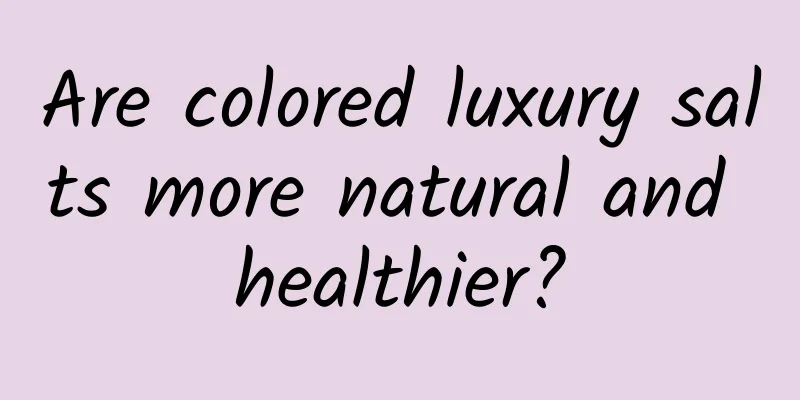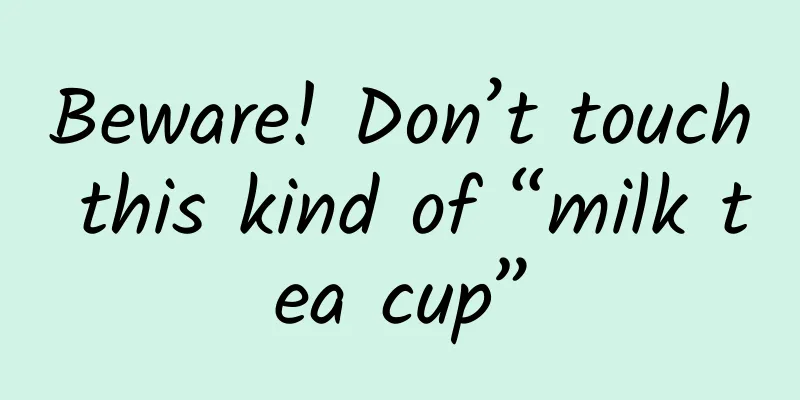Are colored luxury salts more natural and healthier?

|
Recently, several reporters asked: Are those salts imported from all over the world, which are elegant in color, such as pink, light yellow, or light gray, and claim to contain a variety of trace elements and are more natural and healthier , such as rose salt, really more nutritious? They cost hundreds of yuan, so are they really worth buying? This question needs to be discussed from several aspects. First, do they meet food safety requirements? Second, do they have higher nutritional value? Are their health effects irreplaceable? Third, do they provide special value to consumers? Let's talk about the first question first. As a food ingredient, salt needs to meet safety standards. From a microbiological perspective, we don’t have to worry. Salt is the oldest preservative, and as long as the salt content is high enough (for example, up to 20%), there is no need to worry about microbial proliferation. Any salt can easily exceed this standard. However, it is still necessary to check whether there are toxic elements exceeding the standard in the salt. For example, there are national standards for polluting elements such as lead, arsenic, mercury, and cadmium. For example, aluminum and bromine also have potential health risks. Trace elements such as copper, iron, and zinc are beneficial to health in small amounts, but too high a content is also harmful. Products that can be legally sold in our country have all undergone relevant testing, so there is no need to worry about their safety. Now let's talk about the second question. Does high-grade salt have higher nutritional value? Ordinary table salt contains more than 99.5% sodium chloride. "Impurities" other than sodium chloride can give salt special colors, such as light pink, light green, light gray, light yellow, light brown, etc., which are very different from ordinary salt. As long as they meet safety standards, some nutrients in salt other than sodium chloride are beneficial and harmless. For example, potassium, calcium, magnesium, iron, zinc, copper, manganese, etc., when present in small amounts, are advantages rather than disadvantages. For example, a high-end salt that has been very popular in recent years is called rose salt, also known as Himalayan salt. Its advantages are high content of magnesium, calcium and silicon, and high iron content. In fact, the presence of iron compounds is the main reason for its beautiful pink color. However, since the amount of salt a person eats in a day is very limited, relying on eating salt to supplement these nutrients is actually not very effective. According to the data obtained by the media from the authoritative institutions, for example, if you eat 5 grams of rose salt a day, you can only get less than 2 mg of iron, which is far from the 20 mg of iron required by women of childbearing age a day, and cannot be used as the main source of dietary iron. At the same time, the absorption and utilization rate of iron has not been measured and cannot be evaluated for the time being. Rose salt contains relatively high amounts of silicon, which may have an effect on bone health. 5 grams of salt contains about 10 mg of silicon. However, there is still controversy over whether silicon is an essential element, and China has not set a standard for silicon intake, so it is uncertain whether it can have any benefits. Magnesium and calcium are essential elements for the human body, which are beneficial for controlling blood pressure, calming emotions and strengthening bones and teeth. Magnesium chloride and calcium chloride have a slightly bitter taste, which can add a little special flavor to salt. Residents in some areas like to use slightly bitter coarse salt when pickling vegetables, which contains a little magnesium. According to the current nutrient reference intake in my country, the daily magnesium intake reference value for non-pregnant adults is 330 mg, and the calcium reference value is 800 mg. Every 5 grams of rose salt contains about 37 mg and 25 mg of calcium, which has some effect on increasing magnesium intake (exceeding 10% of the reference value), but the significance of calcium supply can be ignored (only 3% of the reference value). The potassium content in rose salt is relatively low, only about 1% of the sodium content, so it has no practical significance in replenishing potassium . To increase potassium intake, it is better to buy low-sodium salt directly, which contains about 25% potassium chloride. In fact, people don’t need to rely solely on eating rose salt to achieve the effect of supplementing magnesium and calcium, because without it, as long as other foods are properly matched, magnesium and calcium can be easily supplemented. For example, brine tofu (northern tofu) has a magnesium content of more than 60 mg per 100 grams, and it is cheap. Eating 100 grams of brine tofu can replenish about 20% of the total magnesium needed by the human body in a day, and it can also replenish more than 100 mg of calcium, as well as protein, soy isoflavones and other beneficial nutrients. Drinking a cup of milk can replenish more than 200 mg of calcium and more than 20 mg of magnesium, and eating 200 grams of rapeseed can also help the human body replenish 200 mg of calcium and 50 mg of magnesium. Finally, let’s talk about the third question: What special value does high-end salt provide to consumers? In other words, why are consumers interested in buying them? This is what netizens said. ——I buy high-end salts in various colors because they look nice and can be used as decorations in the kitchen. ——When I cook steak, I add a little high-grade salt, which makes the flavor better and more ritual-like. ——I think rose salt is not so salty and more nutritious. It also reduces the psychological burden after adding salt. A commodity can have multiple attributes. From a market perspective, the nutritional value of food is not necessarily directly linked to its price . Some foods are relatively cheap but have high nutritional value; some foods are expensive but not very nutritious. Food prices are determined by costs and supply and demand . High prices are not the reason why imported high-end salt must have high nutritional value. Rarity and marketing concepts are the reasons why it is expensive. There is nothing wrong with people who like to use it to decorate their kitchens, using it as a one-time "soft furnishing" or collecting it as a rare souvenir. Some chefs pay attention to flavor details and use specific types of high-end salt when making high-end dishes. It is true that some trace elements may affect the taste of food. For example, iron and copper can promote the oxidation of certain flavor substances during heating, which may bring subtle flavor differences . For chefs, adding some new flavors and new concepts to food is a pursuit of excellence; for diners, it is both a sense of ritual and a psychological satisfaction. In fact, these salts are not luxury products in their production areas, but common things. ——Locally, it is generally used to make bricks for cattle and sheep to lick, and it is sold at a high price for people to eat, which makes me laugh to death. ——These are all marketing tricks used by businessmen. They make themselves look more prestigious by changing their names. In fact, buying these niche salt products produced in developing countries is not a bad thing if it helps improve the lives of local residents and improve trade balance. After all, the daily consumption of salt is very small, and even if a pound costs hundreds of yuan, it will not make anyone bankrupt. Whether to use these high-priced salts is entirely a personal choice. Some netizens also said: ——High-end salt such as rose salt is rock salt, which may not contain microplastics like sea salt and is safer. In fact, if you are just afraid of microplastics, you can buy domestic rock salt. China has a huge reserve of rock salt, enough for Chinese people to eat for decades. Furthermore, if you are really afraid of microplastics, it may make more sense to use fewer disposable lunch boxes and drink less bottled water. Finally, to sum up, there are a few things to remind you about buying salt products: 1. Find out what kind of person you are and why you buy salt . If you buy it for a special flavor, or for curiosity or decoration, that's fine. You won't go bankrupt if you buy some luxury salt. But it's best not to buy it blindly because you're being fooled. 2 If you want to help control blood pressure and prevent cardiovascular and cerebrovascular diseases , then when you buy salt in the market, you must pay attention to the sodium chloride content. Low-sodium salt contains more than a quarter of potassium chloride, and some also add a small amount of magnesium chloride. Its sodium content is 25%-30% lower than pure refined salt. Directly buying ordinary low-sodium salt is enough to produce health effects (without using extra salt), and the price is not much higher. Although you may feel that the taste is slightly different at first, as long as you insist on using it according to the daily salt dosage, you will soon get used to it after one or two months. 3 Some high-end salts contain slightly higher levels of potassium, magnesium, iron and other elements, which may help supplement the corresponding trace elements, but after all, the amount of salt used is not large, and the total amount of trace elements they can provide is limited, and they cannot replace the nutrition of other types of rich foods. If the diet is not lacking in corresponding trace elements, it is even more difficult to see obvious health benefits. 4 Some natural salts contain trace amounts of silicon, boron, strontium, lithium and other elements, which have not been confirmed as essential elements for the human body. Whether it is beneficial to supplement from salt has not yet been determined medically . Whether to pay a high price for it is a matter of personal choice. 5 Regardless of what trace elements it contains, salt is not something that should be consumed in excess. It is recommended to follow the dietary guidelines and control the amount of salt to 5 grams per day. If you consume more high-grade salt because it is "nutritious", although the amount of trace elements may be a little higher, sodium chloride is still the main component, and excessive sodium intake is not conducive to the prevention of high blood pressure, gastric cancer and osteoporosis. In short, it is not a bad thing that "natural salt" with different concepts can provide some trace elements. If people can reduce the amount of salt used in cooking due to the high price of these "high-end salts", it is a good thing . After all, a rich and colorful product supply and multiple price levels are the commodity market conditions that a developed society should have. Reprint/ Cooperation please contact Weibo/ Official Account: Fan Zhihong_Original Nutrition Information |
<<: Daily Science | Fibonacci Sequence: The Shining Pearl in the Crown of Mathematics
Recommend
Baidu information flow promotion, telephone consultation advertising style!
Telephone consultation style 【Bidding Advertising...
Anyang Mini Program Production Company, how much does it cost to produce an office supplies mini program?
More and more businesses are paying attention to ...
"King of Metal" - Why are most metals named after it?
Gold is a popular precious metal that is so valua...
Case Study: 6 Methods of Growth Hacking
The article mainly introduces two strategic imple...
What has happened on Earth in the past 4.6 billion years?
Speaking of the history of the Earth, it may be c...
Didi’s disruption of ride-sharing: an ill-timed gamble
Following the express service, Didi recently laun...
Facebook releases React Native for Android
[[149937]] Facebook today released React Native f...
The entire process of live streaming with goods on Douyin!
In addition to the popularity of short videos, li...
Li Chen's personal profile: How to determine whether a website has been punished by Baidu?
If the website traffic drops sharply during opera...
When "National Hypertension Day" meets Cold Dew, how can we get through it smoothly?
Author: Liu Machao Department of Cardiology, Xuan...
How to do SEO for a portal website? SEO ideas for local portals and vertical portals
Table of contents: 1. What is the difference betw...
KOL Marketing: Xiaohongshu’s High-Quality Short Video Influencer Screening Guide
At present, short videos, as a dark horse in traf...
Those who only look at the CTR of information flow ads are all hooligans! Attached effect case
Most of the articles on the market about informat...
Tencent's ride-hailing code launches two new features: finally you can stay in bed a little longer
On June 3, Tencent's ride-hailing code launch...
Spring is here and you may need some coolness!
During the spring equinox, the sun is shining and...









